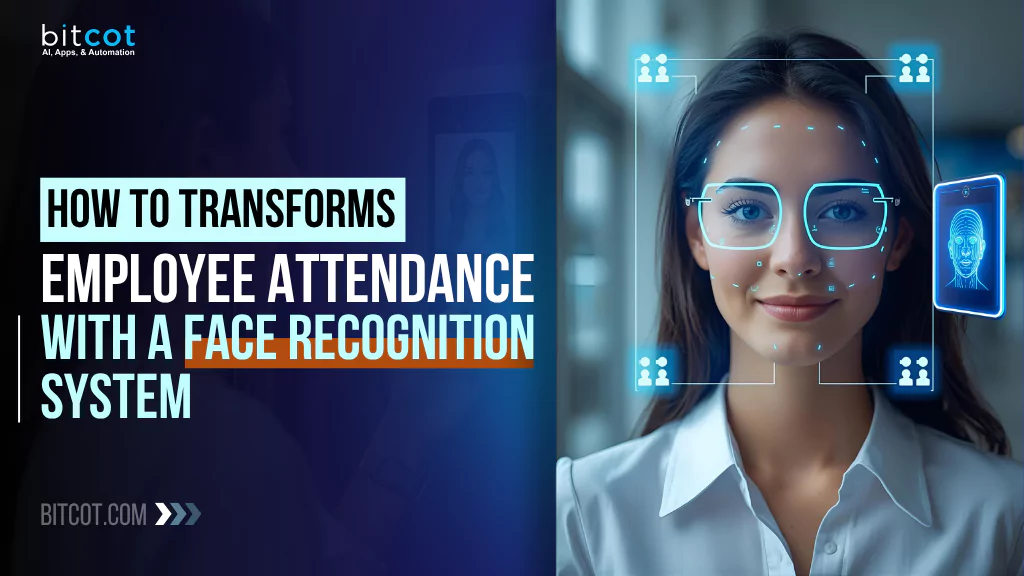
Remember the days of punch cards, sign-in sheets, or those clunky biometric machines where you’d awkwardly press your finger down multiple times before it finally worked?
Managing attendance has always been one of those necessary but not-so-exciting parts of running a workplace. It’s not just about knowing who’s present; it’s about keeping operations smooth, ensuring accountability, and saving everyone time.
That’s where AI steps in, giving even the most routine processes a smart upgrade.
Face recognition technology is quickly replacing outdated systems, making attendance tracking seamless, contactless, and more accurate than ever before.
No more long queues at the office entrance, forgotten swipe cards, or “buddy punching” (where someone clocks in for a friend). Instead, employees can just walk in, and the system does the work in the background.
In this blog, we’ll dive into how AI-powered face recognition is transforming attendance management. From boosting workplace efficiency to strengthening security, this technology is changing the way organizations think about timekeeping. And if you’ve ever wondered whether it’s just a futuristic gimmick or a practical game-changer, you’re about to find out.
Common Challenges With Traditional Attendance Systems
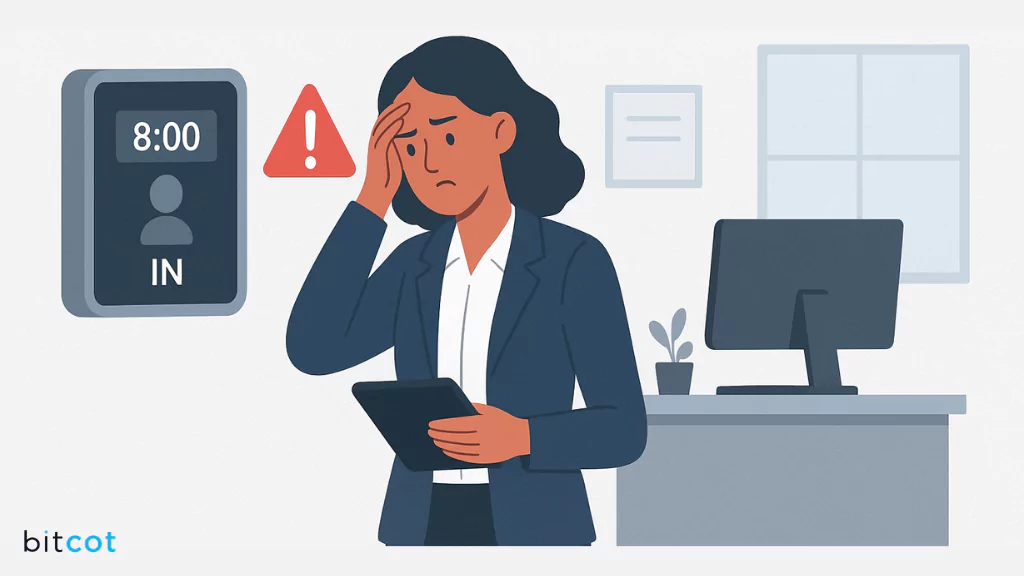
Even in modern workplaces, many organizations still rely on traditional attendance methods like punch cards, manual registers, ID cards, or fingerprint scanners.
While they technically work, these systems come with a variety of challenges that affect productivity, accuracy, and employee satisfaction:
- Human Error and Manual Mistakes: Traditional systems depend heavily on manual input, which can lead to errors like missed signatures, misplaced records, or misread punch cards. Over time, these small mistakes add up, causing HR teams to spend hours verifying, correcting, and reconciling timesheets; time that could be better spent on strategic initiatives.
- Buddy Punching and Attendance Fraud: One of the most common issues is “buddy punching,” where one employee clocks in or out on behalf of another. In large organizations, this can result in significant payroll losses and inaccurate productivity data. Manual methods lack any reliable verification to confirm that the person checking in is actually the employee.
- Time-Consuming Processes: Fingerprint scanners may fail, ID cards can be forgotten, and paper registers often require employees to queue during busy hours. These delays are frustrating for employees and reduce overall workplace efficiency, while managers spend extra time managing exceptions and late entries.
- Hygiene and Contact Concerns: Shared devices such as fingerprint scanners or punch buttons are high-touch surfaces. Repeated contact increases the risk of spreading germs and illness, especially in large offices or post-pandemic workplaces, making these systems less safe and comfortable for daily use.
- Limited Insights and Reporting: Traditional systems only capture basic check-in and check-out times. They don’t provide actionable insights like patterns in punctuality, absenteeism, or overtime. Managers often have to manually compile and analyze data, which is time-consuming and prone to errors, leaving them without the insights needed for informed decisions.
- Scalability Challenges: As organizations grow, traditional systems struggle to keep up. Adding new employees, multiple shifts, or additional office locations complicates management and increases the likelihood of mistakes. These methods simply don’t scale efficiently, making growth harder to manage.
These challenges highlight why modern workplaces are turning to smarter, automated solutions.
The good news is that AI face recognition attendance systems address all of these pain points, offering a faster, more accurate, and secure way to manage employee attendance.
What is an AI Face Recognition Attendance System?
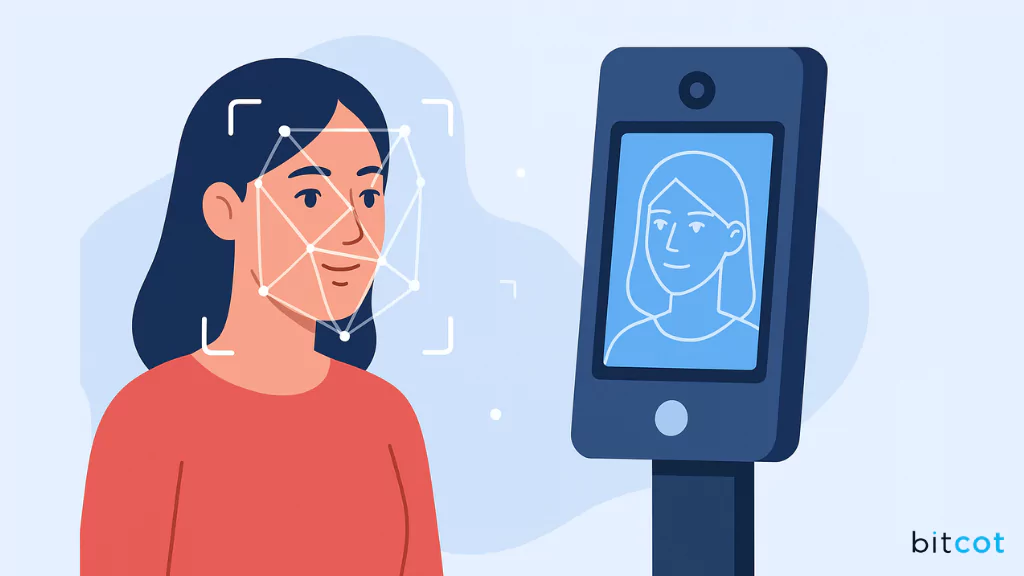
An AI face recognition attendance system is a biometric time-tracking solution that uses artificial intelligence to identify employees based on their facial features and automatically record their attendance.
In other words, it replaces manual registers, swipe cards, and fingerprint scanners with a contactless, AI-powered process that recognizes each person as they enter the workplace.
The system works by capturing an image of the employee through a camera at the entry point.
The AI software then analyzes and maps unique facial characteristics, such as the distance between the eyes, the curve of the lips, or the contour of the jawline, and compares this data with stored employee profiles. When a match is confirmed, the attendance is logged instantly, without the need for manual action.
What makes this technology valuable is its blend of speed, accuracy, and convenience. Unlike fingerprint scanners, which can be slow or unreliable, or ID cards, which can be lost or shared, face recognition is seamless and nearly impossible to fake. Employees don’t have to pause at a machine or carry anything with them; they simply walk in naturally, and the system takes care of the rest.
For businesses, the advantages go far beyond convenience. An AI face recognition attendance system eliminates problems like “buddy punching,” ensures accurate time records for payroll, and provides HR managers with real-time data and reports.
The AI continuously learns and adapts to small changes in appearance, like new hairstyles, glasses, or even natural aging, so the system remains reliable over time.
In simple terms, this technology offers a smarter, more secure, and future-ready way to manage employee attendance, making it easier for companies to save time, reduce errors, and streamline their daily operations.
Why AI Face Recognition Attendance Systems Matter
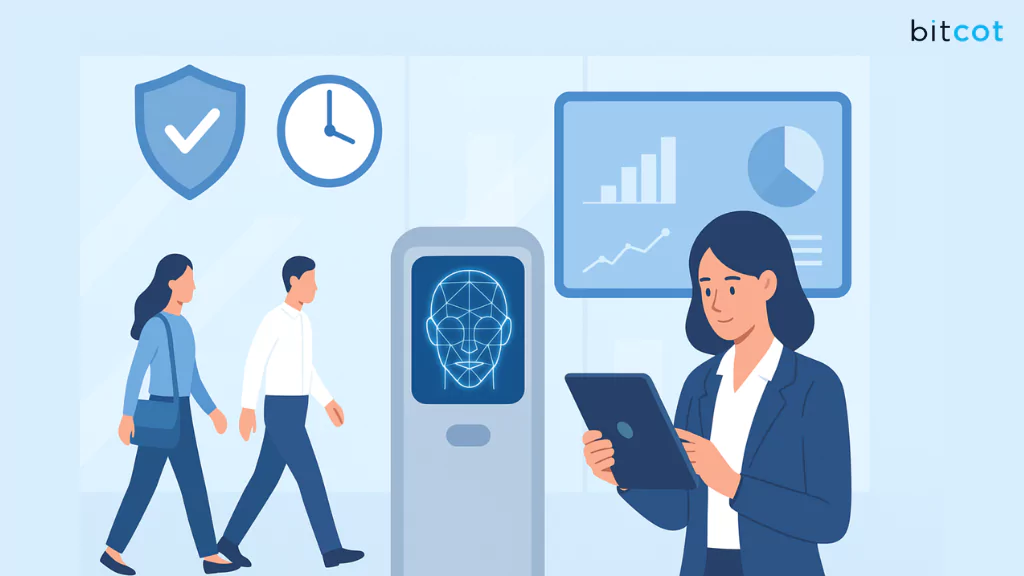
Tracking employee attendance may seem like a small part of running a business, but anyone who has managed a team knows it’s a source of constant headaches.
Long queues at entry points, lost ID cards, unreliable fingerprint scanners, and “buddy punching” can disrupt operations, cause frustration, and even impact payroll accuracy.
AI face recognition attendance systems solve these problems by combining speed, accuracy, and intelligence.
Here’s why they really matter:
Accurate and Reliable Attendance
Manual sign-ins, swipe cards, or fingerprint scanners can be manipulated, lost, or forgotten. AI face recognition systems identify each employee using unique facial features, eliminating mistakes and ensuring that the right person is always marked present. For HR teams, this means no more double-checking or correcting attendance logs, and payroll can be processed confidently.
Time-Saving and Efficient
Think about the time wasted in long morning queues at the office entrance. Employees swipe cards, struggle with fingerprint scanners, or wait their turn to sign in. With AI face recognition, attendance happens automatically as employees walk in. No lines, no waiting, no extra steps. Over hundreds of employees, this adds up to significant time savings every day, making mornings smoother.
Enhanced Security and Fraud Prevention
Security is another reason these systems are essential. Buddy punching or unauthorized access is a real concern in workplaces. AI face recognition prevents such issues by ensuring that only the actual employee is recognized. Advanced features like liveness detection make sure the system cannot be fooled by photos or videos. This gives managers peace of mind while keeping sensitive areas secure.
Real-Time Insights and Reporting
AI attendance systems do more than mark who’s in or out; they provide actionable insights. Managers can view real-time dashboards, monitor punctuality trends, track absenteeism patterns, and identify overtime hours. This data helps in planning shifts, improving productivity, and rewarding consistent performers. Unlike traditional methods, insights are immediate and easy to use.
Adaptability and Future Readiness
Workplaces are evolving with flexible hours, hybrid models, and growing teams. AI face recognition systems scale easily to accommodate these changes. They learn and adapt to variations in employee appearance, lighting, and angles, maintaining accuracy over time. Implementing such a system ensures the workplace is prepared for the future, making attendance tracking seamless.
Improved Employee Experience
Finally, these systems make life easier for employees. No more rushing to swipe cards, struggling with faulty scanners, or worrying about someone else clocking in for you. The contactless process is smooth and stress-free, letting employees focus on their work rather than administrative hassles. When attendance becomes effortless, morale and workplace satisfaction improve naturally.
How AI Face Recognition Attendance Systems Work
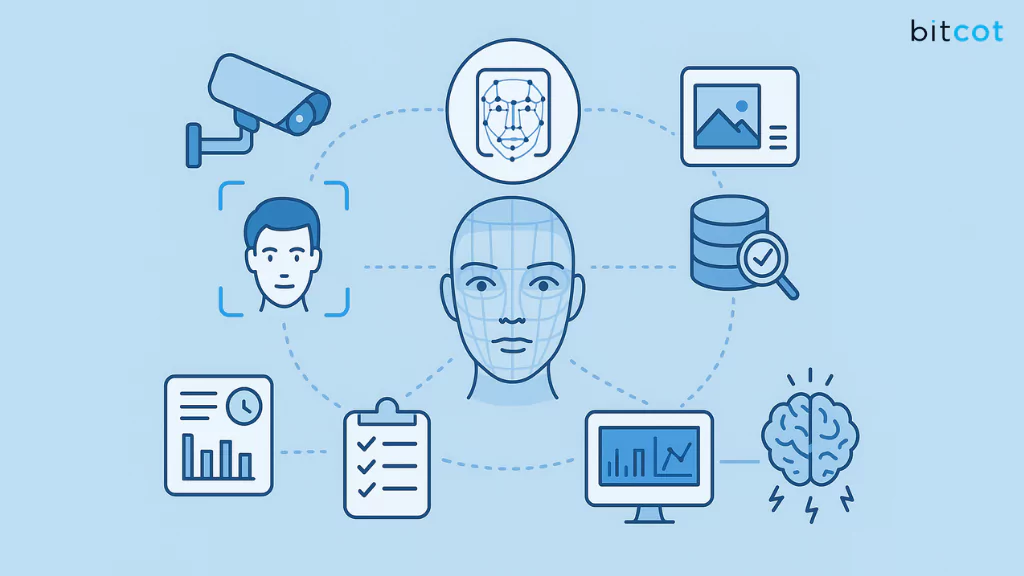
An AI face recognition attendance system automates employee time tracking using artificial intelligence and biometric technology.
Unlike traditional methods like swipe cards or fingerprint scanners, it works contactlessly, making attendance logging seamless and efficient.
Below is a detailed, step-by-step explanation with each step written to the same length.
1. Image Capture at Entry Points
When employees enter the workplace, cameras installed at entry points capture their facial images in real time. The system can handle multiple employees at once, even during busy periods. This process is completely contactless, so employees don’t have to touch devices or wait in lines. Captured images are immediately sent to the AI software for processing.
2. Facial Feature Extraction
The AI software analyzes the captured image and identifies key facial landmarks. These include the distance between the eyes, the shape of the nose, the jawline contour, and the curve of the lips. Each measurement is converted into a unique numerical code called a facial template. This template acts as a biometric signature for the employee. It ensures that each individual can be reliably identified.
3. Image Preprocessing and Normalization
Before matching, the system preprocesses the image to improve accuracy. It adjusts for lighting differences, head angles, and facial expressions. The image is normalized so recognition works even if the employee enters from a side angle or under dim lighting. This step reduces errors caused by environmental factors. It prepares the data for accurate comparison with stored profiles.
4. Matching with the Database
The facial template is compared with the employee database to find a match. Machine learning algorithms enable the system to perform rapid and precise recognition. Even large workforces can be processed without slowing down entry. Multiple employees can be recognized simultaneously. This step ensures reliable identification and prevents errors caused by manual attendance methods.
5. Identity Verification and Validation
Once a match is found, the system verifies the employee’s identity. Advanced AI includes liveness detection to confirm the face is real and not a photo or video. The system can recognize subtle changes over time, such as glasses, facial hair, or aging. This guarantees consistent accuracy for long-term use. It also prevents fraud and “buddy punching” attempts.
6. Automatic Attendance Logging
After verification, the system logs attendance automatically. Check-in and check-out times, along with total work hours, are updated in real time. HR teams no longer need to manually enter records. This improves payroll accuracy and reduces administrative workload. Employees and managers can trust the data for compliance and reporting.
7. Data Integration and Reporting
Recorded attendance is integrated into HR or payroll software. The system generates dashboards and detailed reports on employee attendance. Managers can monitor trends, track punctuality, and identify absentee patterns. Centralized data simplifies workforce management and decision-making. This step ensures transparency and easy access to all attendance information.
8. Continuous Learning and Adaptation
The AI system continuously improves through machine learning. It adapts to changes in employee appearance and environmental conditions. Recognition accuracy increases over time without manual adjustments. This ensures long-term reliability for attendance tracking. The system becomes smarter and more efficient as it learns from each interaction.
AI Face Recognition vs Other Biometric Attendance Solutions
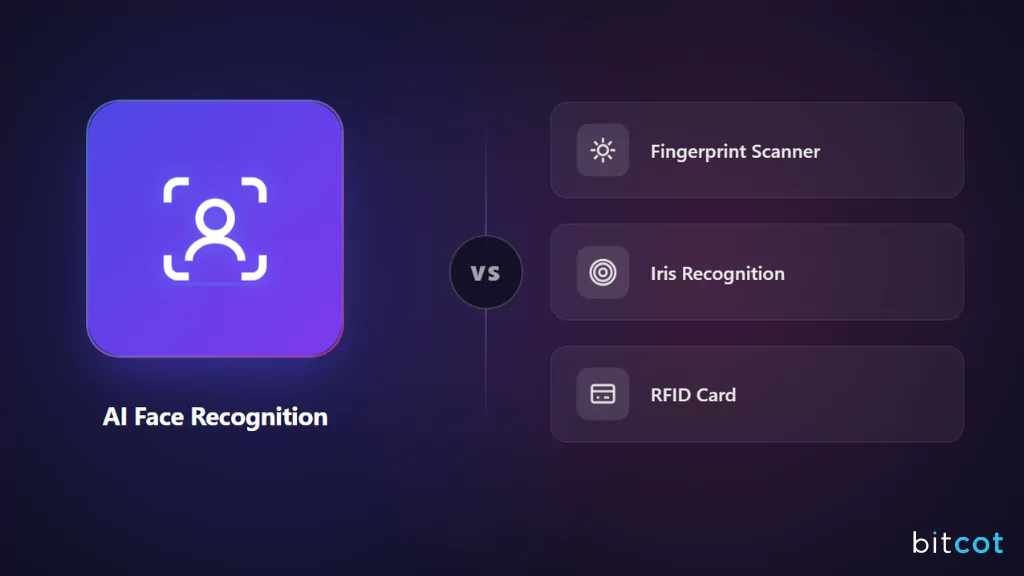
When choosing an attendance system, organizations often compare AI face recognition with other biometric methods like fingerprint scanners, iris recognition, and RFID cards.
Understanding the differences can help you select the most efficient and future-ready solution.
Accuracy and Reliability
AI face recognition offers higher accuracy in identifying employees under various conditions. Unlike fingerprint scanners, which can fail due to dirt, cuts, or worn-out sensors, facial recognition works without physical contact. Iris recognition is also accurate but slower and more intrusive. Face recognition balances speed, accuracy, and convenience for daily attendance.
Contactless and Hygienic
Unlike fingerprint or palm scanners that require touch, AI face recognition is completely contactless. This makes it far more hygienic, reducing the spread of germs, an especially important feature in post-pandemic workplaces. Contactless systems also save time during peak hours, as employees can enter quickly without waiting to use shared devices.
Speed and Efficiency
Face recognition systems can process multiple employees simultaneously in real time. Fingerprint and iris scanners are typically single-user systems, creating queues during busy hours. AI face recognition ensures smooth entry for large teams, saving time and improving operational efficiency while keeping the workflow uninterrupted.
Security and Fraud Prevention
While fingerprint and RFID systems are vulnerable to buddy punching or stolen ID cards, AI face recognition provides enhanced security with liveness detection. It ensures that only authorized, live individuals are recorded. Iris recognition is also secure but less practical for everyday use. Face recognition offers a strong balance of security and usability.
Integration and Scalability
AI face recognition systems easily integrate with HR, payroll, and workforce management platforms. They scale effortlessly as organizations grow, handling more employees, multiple locations, and hybrid schedules. Other biometric systems often require hardware upgrades or additional configurations to scale, making them less flexible for long-term growth.
User Experience
Employees generally find AI face recognition faster, easier, and more convenient than other biometric methods. Fingerprint or iris scanners can be finicky or uncomfortable, and RFID cards can be lost or forgotten. Face recognition provides a seamless experience, encouraging adoption and improving satisfaction without compromising security or accuracy.
| Feature / Criteria | AI Face Recognition | Fingerprint Scanners | Iris Recognition | RFID / Card-Based Systems |
| Accuracy & Reliability | High accuracy in varying conditions; works in crowds and different lighting | Can fail due to dirt, cuts, or worn sensors | Extremely accurate but slower and intrusive | Accuracy depends on card usage; susceptible to lost/stolen cards |
| Contactless & Hygiene | Completely contactless; highly hygienic | Requires physical touch; less hygienic | Requires physical alignment; less hygienic | Contactless but can be stolen or shared |
| Speed & Efficiency | Processes multiple employees simultaneously in real time | Single-user system; queues during peak hours | Single-user; slower recognition | Fast but requires card swipes; queues if devices are limited |
| Security & Fraud Prevention | High security with liveness detection; prevents buddy punching | Vulnerable to buddy punching | Very secure; difficult to bypass | Vulnerable to lost, stolen, or shared cards |
| Integration & Scalability | Easily integrates with HR/payroll; scales across locations and hybrid schedules | Limited integration; hardware upgrades needed for scaling | Moderate integration; hardware-intensive for scaling | Can integrate but requires additional devices; limited scalability |
| User Experience | Fast, seamless, and convenient; minimal effort for employees | Can be finicky and uncomfortable | Less user-friendly; intrusive scanning | Easy but relies on remembering and carrying cards |
How to Build an AI Face Recognition Attendance System
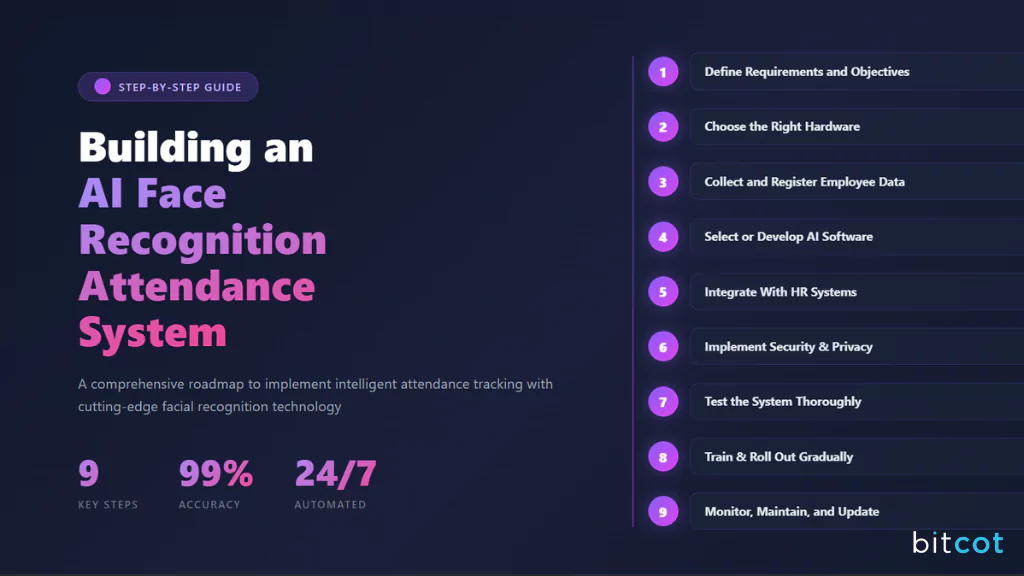
Building an AI face recognition attendance system may seem complicated, but breaking it down into clear steps makes it manageable.
Here’s a detailed, step-by-step guide to help organizations implement a reliable, secure, and scalable system.
Step 1: Define Requirements and Objectives
Before starting, clearly define what you want the system to achieve. Ask questions like: Do you need real-time attendance tracking? Should it support multiple office locations or shifts? Will it integrate with payroll or HR systems? Determine the number of employees, entry points, and reporting requirements. Setting clear objectives ensures that the system aligns with your business needs.
Step 2: Choose the Right Hardware
High-quality cameras are the backbone of any face recognition system. Consider resolution, field of view, low-light performance, and network connectivity. Large offices may require multiple cameras to cover all entry points effectively. Make sure the hardware is compatible with the AI software you plan to use. Proper hardware ensures accurate recognition and smooth operation even during busy hours.
Step 3: Collect and Register Employee Data
The AI system needs a database of employee facial images. Capture clear photos of each employee from multiple angles under good lighting conditions, which are then converted into unique facial templates: digital biometric signatures that allow the AI to recognize each employee. Proper data collection is essential for handling variations such as glasses, hairstyles, or facial expressions.
Step 4: Select or Develop AI Software
Choose a software solution that meets your organization’s needs. Off-the-shelf software can be faster to implement, while custom software solutions offer flexibility. The software should include facial feature extraction, template matching, liveness detection, and the ability to handle multiple faces simultaneously. AI that can learn and adapt over time ensures higher recognition accuracy.
Step 5: Integrate With Attendance and HR Systems
Integrating the AI system with your HR and payroll platforms maximizes efficiency. This allows automatic logging of check-in and check-out times, simplifies payroll calculations, and generates real-time attendance reports. API-based integrations or built-in connectors make this process smoother, reducing manual work for HR teams.
Step 6: Implement Security and Privacy Measures
Facial data is sensitive, so security and privacy are critical. Use encryption for storage and data transmission, implement access controls, and ensure compliance with GDPR or local privacy regulations. Communicate clearly with employees about how their data will be collected, stored, and used. Transparency builds trust and ensures the system is legally and ethically sound.
Step 7: Test the System Thoroughly
Before full deployment, test the system under real-world conditions. Check recognition accuracy across different lighting, angles, and crowded scenarios. Ensure multiple employees can be recognized simultaneously without errors. Identify and fix any misrecognition or latency issues. Thorough testing ensures the system is reliable and ready for daily use.
Step 8: Train Employees and Roll Out Gradually
Educate employees on how the system works and address any privacy or operational concerns. Begin with a pilot rollout in one department or entry point to monitor performance and resolve issues. Gradual implementation ensures higher adoption rates and a smoother transition for all employees.
Step 9: Monitor, Maintain, and Update
AI attendance systems require ongoing maintenance. Regularly update the employee database, apply software patches, and track performance metrics. Continuous learning allows the AI to adapt to changes like new hairstyles, glasses, or aging, ensuring accuracy and reliability over time. Monitoring also helps identify and resolve potential issues before they impact daily operations.
Key Features to Include in Your AI Face Recognition Attendance System
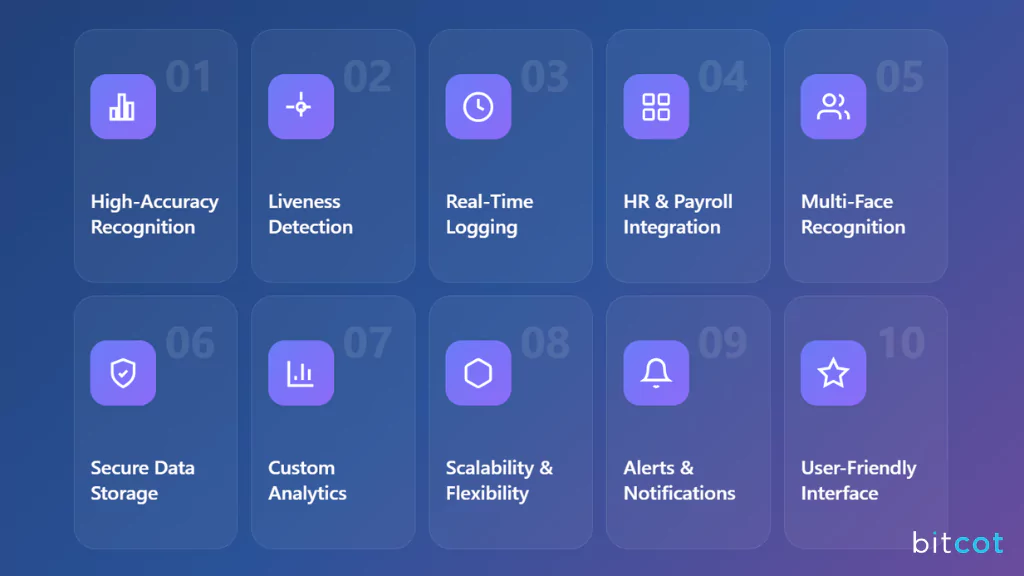
When building or choosing an AI face recognition attendance system, the features you include determine how effective, accurate, and user-friendly it is.
Below are the essential features every modern system should have, explained in detail:
High-Accuracy Facial Recognition
The system must reliably identify employees under varying lighting conditions, from different angles, and even in crowded entry points. High accuracy prevents false check-ins and missed attendance records that could disrupt payroll or shift management. Consistent recognition ensures HR teams can trust the data. Accurate tracking also simplifies reporting, auditing, and compliance processes.
Liveness Detection
Liveness detection ensures the system verifies real, live faces rather than photos, videos, or masks. This prevents buddy punching, unauthorized access, and potential attendance fraud. It enhances overall security for the workplace while building trust among employees. Implementing liveness detection is essential for maintaining the integrity and reliability of attendance records.
Real-Time Attendance Logging
The system should automatically log attendance the moment employees enter or exit. Real-time recording eliminates delays and ensures immediate availability of data for HR and management. Supervisors can monitor employee presence, handle exceptions quickly, and maintain accurate daily records. This feature also reduces time spent on manual verification and improves efficiency.
Integration With HR and Payroll Systems
Integration allows attendance data to feed directly into payroll and HR platforms automatically. This reduces manual data entry, prevents calculation errors, and speeds up salary processing, overtime computation, and leave management. Centralized reporting ensures managers always have an accurate overview of workforce attendance, enhancing operational decision-making.
Multi-Face Recognition
The system must detect and identify multiple employees simultaneously during busy periods without slowing down. This prevents queues and ensures smooth entry for all staff. Multi-face recognition is particularly important for large organizations or offices with high foot traffic. It helps maintain operational efficiency while improving employee satisfaction and workflow.
Secure Data Storage and Privacy Compliance
Employee facial data is highly sensitive, requiring secure encryption and strict access controls. The system should comply with regulations such as GDPR or local privacy laws. Transparent policies for data usage and storage help build employee trust. Secure data handling also protects the organization from legal issues and potential breaches.
Customizable Reporting and Analytics
The system should provide dashboards and reports that track trends like absenteeism, punctuality, overtime, and shift compliance. Customizable analytics allow managers to make informed decisions, optimize workforce allocation, and improve productivity. Detailed insights help identify patterns, address issues proactively, and plan resources effectively.
Scalability and Flexibility
The system should scale effortlessly as the organization grows, handling additional employees, office locations, and hybrid work models. Flexible systems adapt to changes in office layouts, workforce size, and operational requirements. Scalability ensures long-term reliability, consistent accuracy, and smooth performance regardless of company expansion.
Alerts and Notifications
Automated alerts notify managers about late arrivals, absenteeism, or unusual attendance patterns in real time. Notifications can be sent via email, SMS, or mobile apps, enabling proactive management. Immediate alerts reduce the need for constant manual supervision and allow quick corrective actions. This feature ensures workforce management remains efficient and effective.
User-Friendly Interface
A simple and intuitive interface allows both employees and administrators to use the system without confusion. Clear dashboards, easy navigation, and accessible controls reduce the need for extensive training. A user-friendly interface encourages adoption, minimizes errors, and improves overall efficiency. It ensures smooth daily operations and a positive user experience for all.
Key Benefits of AI Face Recognition Attendance Systems
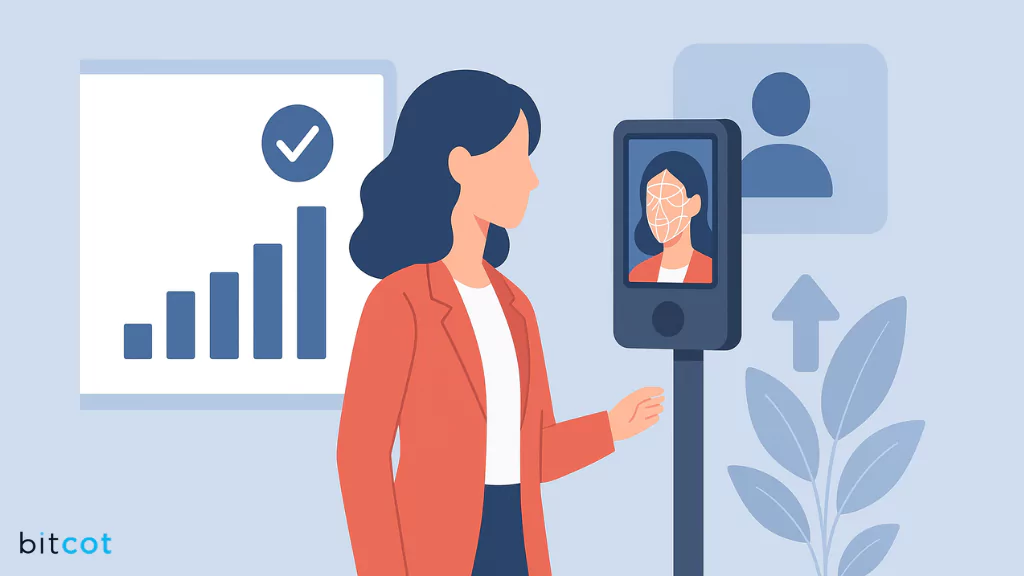
AI face recognition attendance systems are more than just a tool for tracking time; they create real, measurable improvements across the workplace.
By automating attendance, organizations gain efficiency, insights, and a smoother workflow, while employees enjoy a stress-free experience.
Here’s a detailed look at the end benefits:
Streamlined Payroll and HR Processes
Accurate attendance data is the backbone of smooth HR operations. AI face recognition systems automatically log employee check-ins and check-outs, which means HR no longer needs to spend hours verifying timesheets or correcting errors. For payroll, this reduces discrepancies and ensures employees are paid correctly and on time.
For example, in large organizations with hundreds of employees, even a small error in attendance data can create significant delays and frustration; automating the process eliminates this problem completely.
Enhanced Workforce Productivity
When attendance tracking becomes automatic, employees and managers save valuable time. No more waiting in long queues to swipe cards or sign in manually. Teams can start their workday on schedule, reducing idle time and increasing overall productivity.
Additionally, managers can focus on strategic tasks instead of administrative oversight. Over time, this boost in efficiency contributes to smoother operations and more engaged employees who feel their time is respected.
Data-Driven Decision Making
AI attendance systems do more than record hours; they provide actionable insights. Managers can track patterns in punctuality, absenteeism, and overtime, helping them make smarter decisions about staffing, workload distribution, and shift planning.
For instance, if a department consistently shows late arrivals, managers can investigate underlying causes and implement targeted solutions. This transforms attendance data from a basic record into a strategic tool for optimizing workforce management.
Reduced Operational Costs
By eliminating manual attendance processes, paper logs, and outdated devices, organizations save money on administrative overhead. AI systems also prevent fraud, such as buddy punching, which can lead to significant payroll losses over time.
Fewer errors and faster payroll processing reduce compliance risks, ensuring organizations avoid costly penalties. Overall, automation converts what used to be a resource-heavy process into a lean, cost-efficient system.
Improved Employee Experience and Engagement
A seamless, contactless attendance system reduces stress for employees. There’s no need to remember ID cards, struggle with malfunctioning scanners, or wait in long queues. Employees can walk in naturally, have their attendance recorded instantly, and focus on their work.
When routine administrative hassles are removed, morale and engagement improve, creating a positive ripple effect across the workplace. Employees feel valued when systems respect their time and make their daily routines simpler.
Scalable and Future-Ready Operations
AI face recognition attendance systems are highly adaptable. They can scale with business growth, additional office locations, or hybrid work models without compromising accuracy. Continuous AI learning ensures the system adapts to changes in employee appearance, lighting conditions, and workplace layout.
This makes the technology future-ready, so companies can expand confidently while maintaining consistent attendance management.
Stronger Organizational Reputation
Implementing advanced AI systems signals that a company is innovative, efficient, and employee-focused. This can improve employer branding and make it easier to attract and retain top talent. Employees and candidates are increasingly drawn to workplaces that use modern, hassle-free systems that enhance productivity and workplace experience.
A reputation for embracing smart technology can also positively impact client perception and overall business credibility.
Real-Life Use Cases of AI Face Recognition Attendance Systems
AI face recognition attendance systems are gaining traction across industries in the USA, helping companies streamline operations, improve accuracy, and enhance employee experience.
Here’s how different sectors are implementing them:
Use Case 1: Corporate Offices
Many corporate offices across major U.S. cities, from tech hubs like Silicon Valley to financial districts in New York, are using AI face recognition to simplify attendance management.
Employees can check in and out quickly without queuing or touching shared devices. HR teams gain access to real-time attendance data, enabling smoother payroll processing and accurate record-keeping, while employees enjoy a faster, contactless experience.
Use Case 2: Educational Institutions
Universities and colleges in the USA, including large public and private institutions, are leveraging face recognition to monitor student attendance in classrooms and labs.
The system replaces traditional manual registers, saving administrative time and improving operational efficiency. Administrators can track attendance trends, identify absentee patterns, and support students effectively without disrupting daily operations.
Use Case 3: Manufacturing and Industrial Facilities
U.S. manufacturing plants and industrial facilities are adopting AI face recognition to manage shift-based workforces across multiple entry points. The system ensures accurate attendance tracking, prevents unauthorized access, and reduces disputes over hours worked.
Employees experience faster entry, and managers can maintain reliable, automated records for improved operational management.
Use Case 4: Healthcare Facilities
Hospitals and clinics across the U.S. are implementing AI face recognition to manage staff attendance in fast-paced healthcare environments. Contactless recognition is particularly valuable for maintaining hygiene and reducing the spread of germs.
Staff benefit from quick check-ins, while administrators can efficiently manage shifts, attendance logs, and compliance requirements.
Use Case 5: Retail and Customer-Facing Businesses
Retail chains and franchises in the U.S. are using AI face recognition to manage large, rotating teams across multiple locations. The system enables real-time monitoring of attendance and simplifies administrative tasks.
Employees enjoy faster check-ins, and managers can allocate staff efficiently without relying on manual tracking methods, improving both operational flow and employee satisfaction.
ROI and Cost-Benefit Analysis of AI Face Recognition Attendance Systems
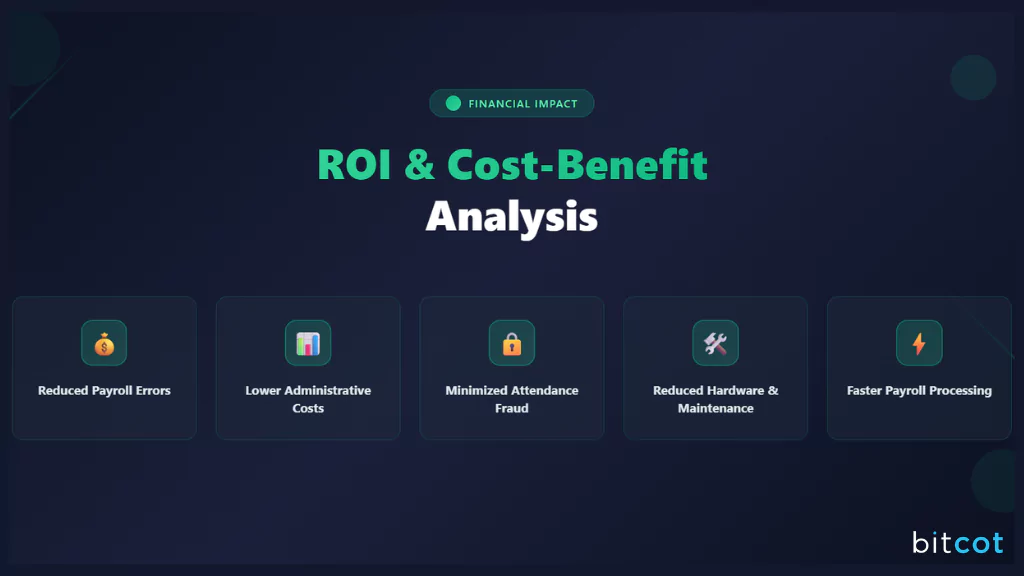
AI face recognition attendance systems provide direct and measurable financial returns for U.S. businesses.
By automating attendance tracking, they reduce errors, prevent fraud, and lower administrative costs.
These systems feed accurate data into payroll, generating tangible cost savings and improving operational efficiency.
Reduced Payroll Errors
Traditional attendance tracking often results in missed punches, inaccurate hours, or buddy punching, causing payroll mistakes. AI face recognition automatically logs each employee’s check-in and check-out times with high accuracy. This ensures precise wage calculations without manual corrections. The direct result is measurable savings on payroll adjustments.
Lower Administrative Costs
HR teams spend significant time manually verifying attendance, reconciling timesheets, and correcting errors in payroll. Automating these tasks with AI reduces the need for manual intervention across departments. Less administrative effort translates into direct labor cost savings for HR teams and the organization as a whole.
Minimized Attendance Fraud
Buddy punching, false entries, and lost ID cards create financial losses in traditional systems. AI face recognition verifies identities in real time and prevents unauthorized check-ins effectively. By reducing fraudulent attendance claims, organizations directly save money that would otherwise be lost. This creates a clear, measurable ROI.
Reduced Hardware and Maintenance Costs
Fingerprint scanners, RFID terminals, and card systems require regular maintenance, updates, and occasional replacements. AI face recognition systems typically require less frequent hardware upkeep and fewer upgrades. This reduction in hardware and maintenance expenses leads to direct financial savings for the business.
Faster Payroll Processing
Manual attendance data requires HR teams to calculate hours, overtime, and leave before processing payroll. AI attendance systems automatically feed accurate data into payroll software, eliminating manual steps. Faster processing reduces labor hours and ensures employees are paid correctly. This generates direct, quantifiable cost benefits.
Future Trends in AI Face Recognition Attendance Systems
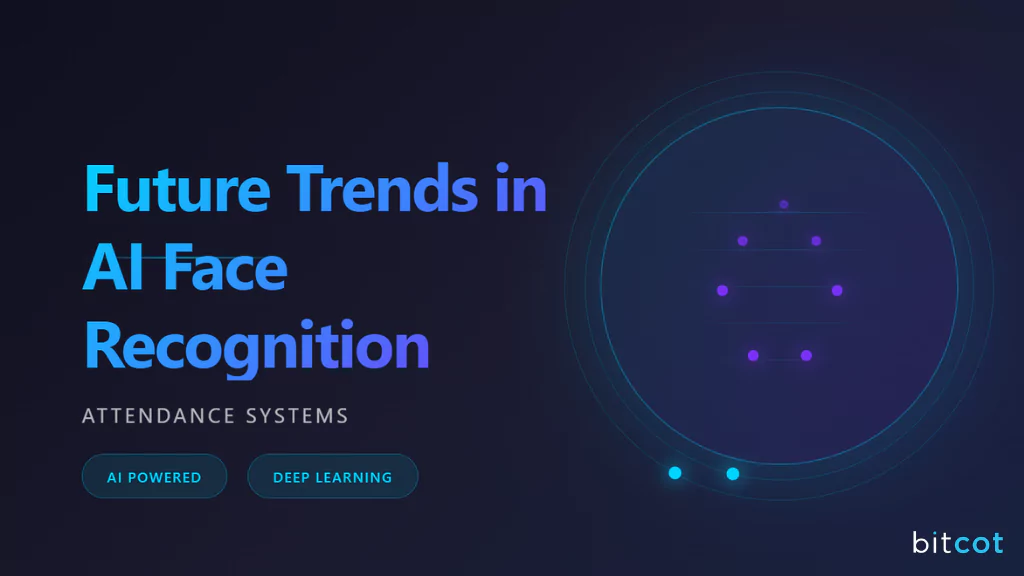
AI face recognition is transforming attendance tracking in the U.S., making it more accurate, secure, and employee-friendly. Emerging trends show how technology will continue to enhance workforce management, streamline operations, and provide actionable insights.
1. Advanced AI and Deep Learning
Future systems will use sophisticated AI and deep learning algorithms to improve facial recognition accuracy in challenging conditions. These systems can handle variations in lighting, masks, hairstyles, and crowded spaces effectively. Enhanced AI reduces misidentifications and increases reliability, even in high-traffic environments.
2. Multimodal Biometric Verification
AI face recognition will increasingly combine with other biometric methods, like voice recognition or iris scanning. Using multiple biometric inputs enhances accuracy and security, even when one modality is partially obstructed. This hybrid approach ensures fraud prevention and reliable verification. Organizations gain a more robust system that works consistently under varied conditions.
3. Integration With Remote and Hybrid Workforces
As hybrid work becomes standard in the U.S., future systems will track attendance both on-site and remotely. Integration with mobile apps, geolocation, and cloud platforms provides a unified view of employee presence across locations. This ensures accurate records regardless of where employees are working. Managers can streamline workforce monitoring and reduce discrepancies effectively.
4. Cloud and Edge Computing Adoption
AI attendance systems will leverage cloud and edge computing for scalability and faster processing. Cloud platforms centralize management for multiple offices, while edge computing enables real-time recognition without relying solely on internet connectivity. This combination reduces operational delays, improves efficiency, and minimizes maintenance costs.
5. Predictive Analytics and Workforce Insights
Next-generation systems will use predictive analytics to forecast absenteeism, late arrivals, and overtime trends. By analyzing historical attendance patterns, HR can optimize scheduling and allocate resources proactively. Predictive insights help prevent staffing gaps and improve operational planning. Organizations gain a strategic advantage by accurately anticipating workforce needs.
6. Enhanced Privacy and Compliance Features
Future systems will prioritize data privacy and regulatory compliance to meet U.S. standards like GDPR and state-specific laws. Features such as encryption, anonymization, and transparent consent management ensure employee trust. These safeguards reduce legal risks while maintaining accurate records. Businesses can adopt AI attendance confidently.
Partner with Bitcot to Build Your Custom AI Face Recognition Attendance System
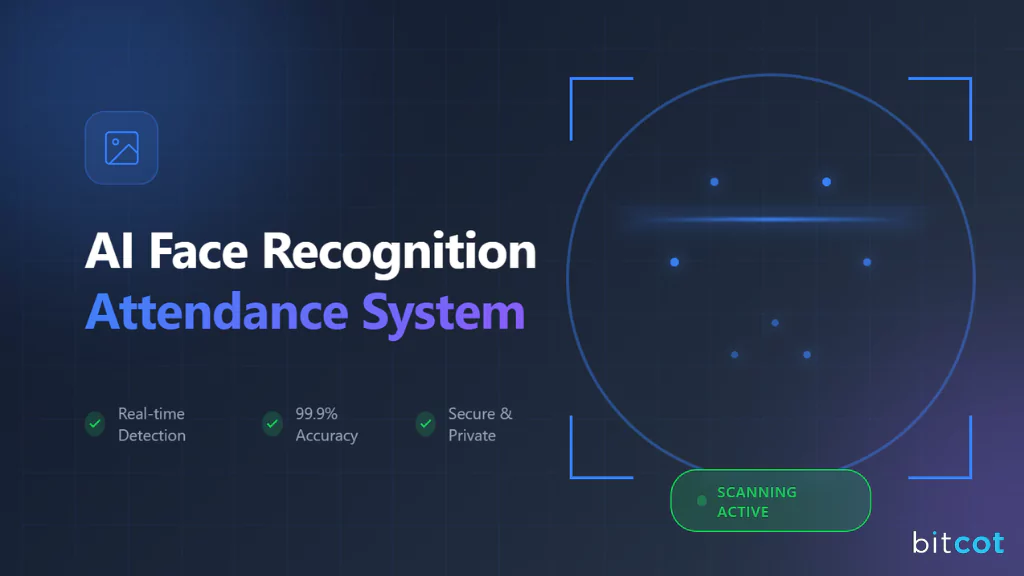
Choosing the right partner is critical when implementing a custom AI attendance system.
Bitcot stands out for its expertise, reliability, and ability to deliver solutions that meet the unique needs of U.S. businesses:
- Proven Expertise in AI and Software Development: Bitcot has extensive experience in developing AI-powered solutions across industries. Our team leverages advanced facial recognition algorithms and deep learning models to create attendance systems that are accurate, secure, and scalable.
- Custom Solutions Tailored to Your Business: We don’t offer one-size-fits-all products. Bitcot designs attendance systems based on your workforce size, office layout, shift patterns, and compliance requirements. This ensures a solution that fits your unique workflow and operational needs perfectly.
- Seamless Integration with Existing Systems: Bitcot ensures that your AI attendance system integrates effortlessly with HR, payroll, and workforce management platforms. This minimizes disruption and maximizes efficiency, providing a smooth, end-to-end solution.
- Commitment to Privacy and Compliance: We prioritize data security and compliance with U.S. regulations. Bitcot implements encryption, anonymization, and consent management features to protect employee data while maintaining transparency and trust.
- Ongoing Support and Optimization: Bitcot provides continuous post-deployment support, including system updates, AI model improvements, and troubleshooting. This ensures your system remains efficient, scalable, and aligned with evolving business requirements.
- Proven Track Record and Client Satisfaction: We have successfully delivered AI-powered solutions for a range of U.S. businesses. Our focus on quality, reliability, and client success makes Bitcot a trusted partner for organizations looking to modernize attendance management.
Partnering with Bitcot ensures your organization receives a cutting-edge, fully customized, and reliable AI face recognition attendance system that drives efficiency, accuracy, and long-term value.
Final Thoughts
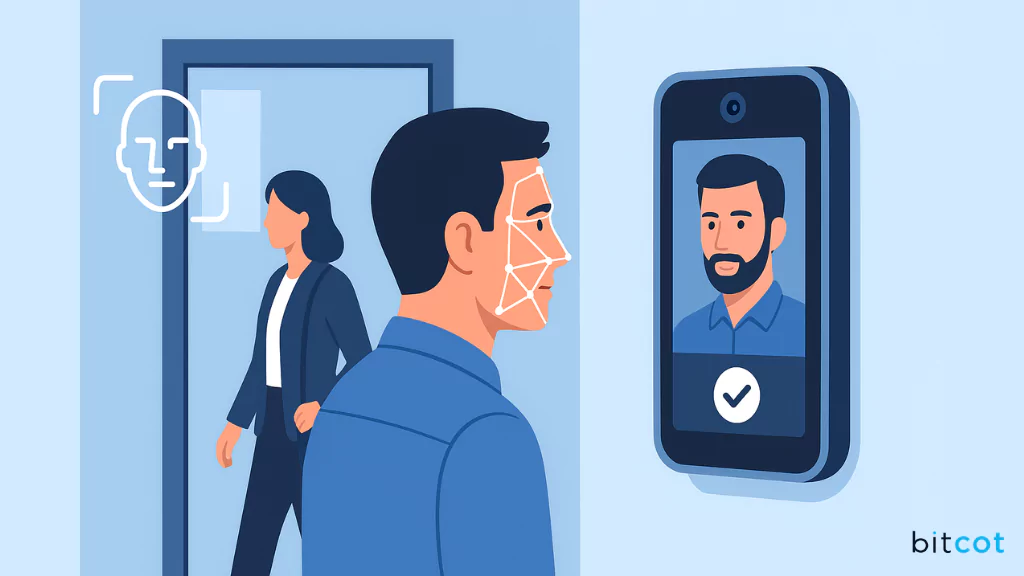
AI face recognition attendance systems are no longer a futuristic concept; they are becoming an essential tool for U.S. businesses looking to streamline workforce management, improve accuracy, and reduce operational costs.
From corporate offices to healthcare facilities, retail chains, and educational institutions, these systems are transforming the way organizations track employee attendance.
The benefits are clear: accurate payroll, reduced administrative overhead, fraud prevention, and real-time reporting.
As businesses continue to embrace digital transformation, investing in a reliable, scalable, and secure AI attendance solution is a strategic decision that drives both efficiency and measurable ROI.
When it comes to implementing a solution tailored to your organization’s needs, Bitcot is the trusted partner for developing custom AI face recognition attendance systems. With expertise in AI, seamless integration capabilities, and a commitment to data privacy and compliance, Bitcot ensures your system delivers maximum value.
Take the next step in optimizing your workforce management.
Choose Bitcot to explore bespoke business software solutions that automate your processes, enhance security, and drive your operational efficiency.
Get in touch with our team.












